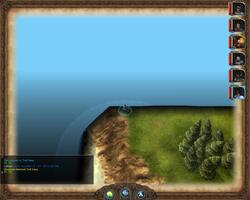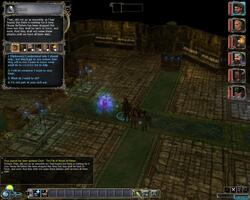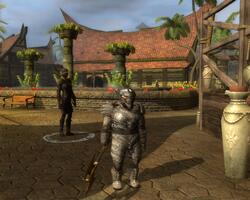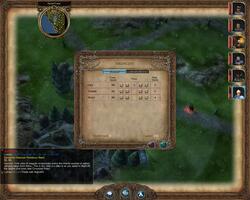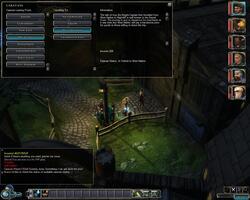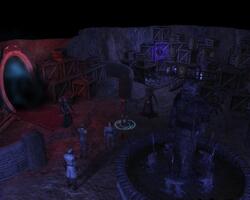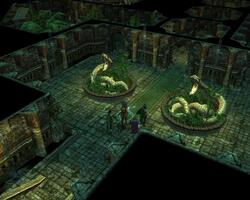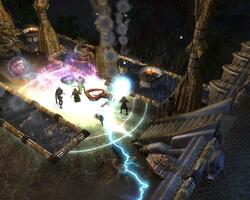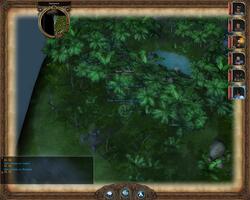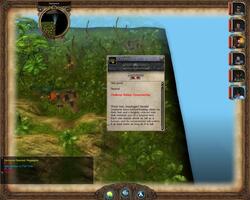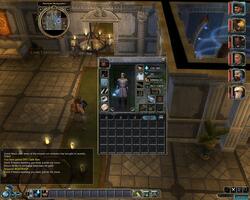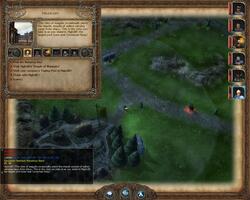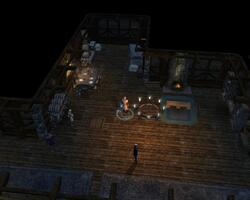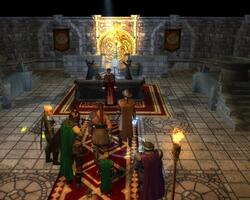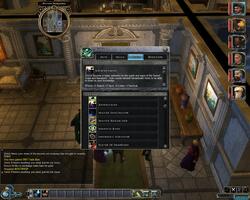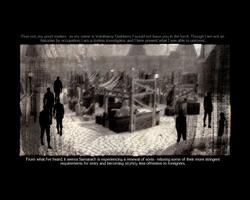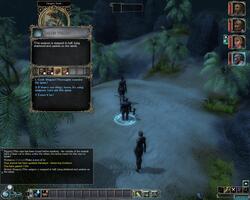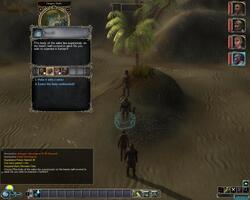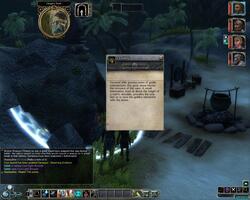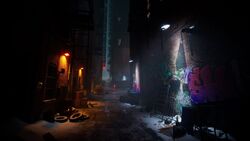Darth Roxor reviews NWN2: Storm of Zehir
Darth Roxor reviews NWN2: Storm of Zehir
Review - posted by DarkUnderlord on Mon 29 December 2008, 03:08:32
Tags: Neverwinter Nights 2: Storm of Zehir; Obsidian EntertainmentOverview
Storm of Zehir is the second expansion to Obsidian Entertainment’s Neverwinter Nights 2. The first add-on – Mask of the Betrayer – was highly acclaimed among computer RPG fans because of its success in the story department and frequently compared to the classic that is Planescape: Torment. When Obsidian announced their new release, many of MotB’s fans were enthusiastically hoping for another epic, grim, story-driven RPG. However, it was stated many times by the developers that Storm of Zehir will be vastly different from the second expansion, since it is more in the vein of combat and dungeon oriented games like Icewind Dale.
Well then, I’m afraid I must disappoint those who were hoping for SoZ to be Mask of the Betrayer 2. In fact, if that’s the only thing that interests you – no, this is not MotB, you may stop reading, turn around and walk away, because the expansions are to themselves what apples are to oranges. But that’s not saying that SoZ is a bad game – quite the contrary, even.
So, what’s new?
Storm of Zehir adds a lot to the original formula of Neverwinter Nights 2 and I shall start with the overland map. The map allows the player to interactively travel through the gameworld, as opposed to the original campaign, where you just clicked the destination you wanted to travel to when you left a location. The map is filled with various locations such as towns, dungeons, caves, crypts etc, that you can uncover during your travels (although some locations are ‘unlocked’ only through quests). It also holds a lot of hidden goodies that will be discovered only by characters with enough ranks in certain skills (for example: if the character you’re controlling on the overland map has enough ranks in ‘craft armor’, you may find a tree with a unique breastplate, enough ‘heal’ will let you find discarded baskets of clothes from which you can scavenge some bandages etc). However, it mustn’t be ignored that the Forgotten Realms are not a safe place,and there are numerous bands of various monsters roaming the roads and wilderness, which makes certain abilities absolutely vital to avoid the random encounters. Encounter related skills are: 'hide' and 'move silently' (to avoid detection on the overland map), 'spot' (to detect monsters from afar) and 'survival' (which increases your party’s speed. Useful for a quick getaway but its main function is just making the trips faster). Each random encounter has an encounter level (EL) assigned to it, which indicates how tough will it be for your party to make it through. If by some unfortunate stroke of bad luck you’re finally caught by a band of monsters, there are several things you can do. If the monsters are intelligent creatures (bandits, greenskins etc) you can parley, which allows you to use the ‘bluff’ skill to lower the enemies’ defenses before attacking, ‘intimidate’ to cause fear, or bribe your way out (lowering the price with ‘diplomacy’) to totally avoid the encounter. Note that you can’t bribe creatures which are not interested in letting you go (yuan-ti, fell trolls, wyverns). If you have a druid or a ranger in your party, and you’re attacked by wild animals, you can use wild empathy to calm the animals or use diplomacy to convince them to let you go. Alternatively, you can also try to run away from an encounter (that happens only once, if the monsters catch you the second time, you’re in for a fight without any other possibilities) or just attack. Each encounter beaten by force gives you experience. Moreover, not all encounters are hostile. There are times where you will meet a wounded woodsman that you can heal or a pirate captain with his crew and have a little chat with them (unfortunately, there aren’t too many of these). You can control one character on the overland map (but you can change them during travels), and only the currently controlled character’s skills count (as in, if you currently control a fighter, your rogue’s level 20 in hide will not count).
Another new feature is the ‘party dialogue’ system. Basically, it allows every companion to speak up during conversations. In the dialogue window, there are portraits of all your party members, and if they have something additional to say (alternative answers depend on various factors, such as alignment, race, class, skills, some cohorts also have unique dialogue lines) a speech bubble will pop up below the portrait.
Storm of Zehir also allows you to create your own, unique party at the start of the game. It’s mandatory to create one member (the leader) who will stay with the party at all times, but after that, you can even totally skip other party members and try to solo the game (if you’re in a suicidal mood). When you have your leader, you can create a maximum of three other party members (or choose some that are pre-made), later on take one cohort, and another one if you have the ‘leadership’ feat. In addition, the three other party members can be exchanged in taverns for others of your liking if you’re not satisfied with them. As for novelties in character creation, there are two new races – gray orcs (which are ‘wise’ orcs that make for good clerics) and yuan-ti purebloods (yuan-ti/human hybrids, powerful, but at +2 level adjustment) and three new classes, with two being prestige classes (Doomguide and Hellfire Warlock) and one base class (Swashbuckler). Unless your party members have level adjustments, they start at level 4.
The last ‘big innovation’ is the trading system. Each city has a stock of resources (skins, timber, ore and one rare resource such as cold iron, adamantine, etc) that you can buy for ‘trade bars’ and later sell in other cities for bigger prices. Crates of resources can also be found on the overland map. In later parts of the game, you can establish trading posts in cities and construct caravans traveling across the land to supply you with trade bars. Caravans are vulnerable to attacks from random encounters, but can be upgraded with gold to raise their level (up to level three) and thus, increase their defenses. The trade bars are a second currency (next to gold) that are used in all merchant related transactions (such as establishing trade posts, climbing higher in the ranks of the merchant factions, buying upgrades for your company) or can be simply exchanged for gold (one trade bar equals fifteen gold pieces).
The Gameplay
As I stated in the introduction, Storm of Zehir and Mask of the Betrayer are two completely different games. I could even say that the only thing they share is the engine. While MotB was an epic journey to save yourself from (or embrace) a curse, SoZ is centered around something someone might call ‘generic adventuring’. Indeed, the focus is put mainly on exploration and going through various dungeons, while at the same time having a continuous income of trade bars from your evergrowing merchant company. Actually, for most of the game, you can completely ignore the main quest and focus on finding new treasures to uncover. Most of the time I spent in the game was on the overland map, not because I was fighting all the time, but because I wanted to visit every single corner to make sure I didn’t miss anything. Every gamer who wants his RPG to have a lot of exploration will definitely find SoZ to be very enjoyable.
The game begins on a ship called The Vigilant. Already at the start, probably all of those who were previously introduced to the Forgotten Realms will recognize one of the passengers, Volothamp Geddarm. The ship is bound to the city of Samargol in the country of Samarach on the jungle-filled Chultan Peninsula (the jungles of Chult have appeared in Icewind Dale 2). Soon, the ship crashes ashore during a particularly strong gale a short trek south of its destination. Your welcoming party is a huge band of native goblins – the Batiri – with which Volo tries to reason with (to no effect). While Volo is distracting the Batiri, you are supposed to check the crash site for anything that might help you in case a fight breaks out. This is also the first place where you will experience something I like to call ‘the skill checks extravaganza’. ‘Diplomacy’ and ‘intimidate’ will allow you to get two other survivors to hand over a longsword and shortbow to you, ‘heal’ and ‘craft alchemy’ will make it possible to harvest nearby shrubs for healing kits and healing potions or create healing kits from sails scattered around, while ‘search’ lets you uncover additional things in nearby debris, such as short swords, spears and magic scrolls when without the skill you could get only wooden planks as makeshift weaponry. These are only a few examples of skill checks in the game.
While walking around the overland map, you will notice a large number of various dungeons and dungeon-like areas. The dungeons in the first area of the game are criminally small, often being composed of about 2-3 rooms with some generic monsters. Fortunately, the dungeons are more advanced in the second part. But while all the caves, even the smallest ones, are rather unique and memorable and looking at the map you’ll always know what resided in the specific location, all of them also scream ‘Please develop me further!’. The only non-compulsory dungeon that was ‘multileveled’ was a shack of the Luskan Arcane Brotherhood, which featured two floors. However, even though they’re small, there’s a whole damn lot of them, and it’ll take you many hours to find them all. Some of the more interesting locations are for example a temple of Umberlee, a house full of hunters murdered by a maddened druid of Malar or a half-flooded, undead infested mine with a grim past. Some of the dungeons require quite a lot of tactics and defensive spells to pull through, and often I needed to reload the game because I was just getting steamrolled. The fact that there is actual ‘challenge’ in the game is something very good in today’s era of dumbed down console trash that practically gives the player IDDQD.
It's been stated in the RPG Codex review of Mask of the Betrayer that its spirit meter was a ‘moron indicator’. In Storm of Zehir, the ‘moron indicator’ is the overland map. Checking throughout various forums on the internet, you will probably find an abundance of people complaining that they can’t avoid the random encounters. Well, this only shows that people avoid (or just can’t read) pop-up tips and the manual, both of which state how the encounter system works. Only one skill is needed to have almost absolute peace on the overland map, and that skill is either ‘hide’ or ‘move silently’, because thanks to these, you just avoid detection. But well… if people want to take four fighters and then whine about being attacked every five seconds, I have no further questions. I had a ranger in my party (which means high hide, spot, survival), and I could run around the overland map almost completely without problems (very rarely did it happen that I failed a hide check). The one thing I can agree with is that the number of random encounters should be lowered, but mainly because it doesn’t seem quite believable that roads of the Sword Coast (to which you return later) are literally swarming with monsters. Also, beating random encounters gives a huge amount of experience – taking out an encounter whose encounter level is bigger by 2 or 3 than your party’s level will give you around 300 xp in earlier parts of the game, and around 700 in the later ones – while avoiding one gives none. It would be better if you’d get xp for both of them, and the one for beating the encounters should be drastically lowered in my opinion.
It was said before the game came out that it’ll feature new AI that’s supposed to be much more intelligent. Although the AI is an improvement over the previous parts of NWN2, it still leaves a lot to be desired. For example, you can toggle auto-spellcasting from ‘overkill’ mode (when wizards use meteor shower on goblins) to a much more ‘economical’ spellcasting (where they’ll stop dropping meteor showers on goblins, which didn’t always happen in the previous games), but you just can’t stop party members from attacking on sight, even if you totally turn off melee and ranged attacks, and the smallest ‘guard’ range, which determines when the party members will rush to attack, is still too big to me.
Another tricky part of the expansion is the difficulty, which can be only described as ‘inconsistent’. Let’s take Samarach as an example: when you have a fresh made party, a group of ogres (encounter level: 6) will probably beat all your intestines out of you, while a group of Batiri (EL:8) will be no problem at all. Furthermore, in the jungle you will find an old yuan-ti temple where the yuan-ti there will be described as ‘challenging’ at party level 9 and fighting more than two at once is almost certain death because nearly every second hit made by them is a critical hit, while an encounter of also ‘challenging’ will-o-wisps on the overland map can be easily beaten without taking a single point of damage. Also, the encounter difficulty will be rather challenging at first, but once you get some levels, they are just too easy (basically, when you get to level 7 in Samarach, you don’t need to fear anything, same in the Sword Coast when you get to level 11-12). Fortunately, the difficulty is a lot higher in the handplaced locations, and I guarantee there’ll be many times where you’ll be just running away from a dungeon, thinking, ‘damn, I really had my arse handed to me’. Another thing tied to the difficulty is the amount of money you’ll get. Once you establish a few trading posts and caravans, go explore a bit on the overland map, and return to your base of operations to claim your share of income in trade bars. You’ll get loads and loads of money which will soon become meaningless, because of how much you will have.
Note that characters can die now. When a party member gets to 0 health, he drops unconscious, and loses 1 health point per 6 seconds. When he drops to minus half of his maximum hp, he’ll die for good, which means spells like ‘raise dead’ and ‘resurrection’ finally have a use. But while you have to be double-careful to not get party members killed, resurrecting them is hilariously easy (thanks to the overabundance of money). In temples of Waukeen that are placed in every city, you can buy ‘coins of life’ for 400 gold, which are basically ‘raise dead’ scrolls usable for all characters, which does eliminate the threat factor by a lot. Another inconsistent aspect of the game is resting. On one hand, you can’t rest anywhere else than on the overland map (which is dangerous) and in taverns (which costs), but then, you’re almost always in close vicinity of a city, and the fee for resting in a tavern is laughable (50 gold).
While we’re talking about cities, they also aren’t really made too well. Except for four cities, all of them are composed of a tavern (which stores an innkeeper, some generic patrons and always one quest giver), a temple of Waukeen (priest that sells some very basic supplies), and your trading post if you establish one (which stores workbenches).
Another rather interesting feature are the party feats. You can get them in various ways, mainly for completing quests or clearing out dungeons, but there are some that you can acquire in the Adventurers’ Guild and these are a bit more tricky. The first type of feat is more of your party’s ‘fame’, and not always do they give bonuses. You get these, for example, by visiting the locations on the map and reporting them to Volo – each location counts to your ‘tourist’ feat which gives bonuses to skills like survival, search, spot etc. An example of a, well, useless feat is ‘bane of the banites’, which you get for clearing out a den of outlaws, but this one doesn’t give any bonus. To get the feats from the Adventurers’ Guild requires some steps to be taken first. For starters, everyone in your party needs to have some ranks in certain skills, then you have to pay for training, and to finish your training and get the feat, you have to do a quest. It’s also a shame that some of the feats of ‘fame’ don’t give you anything, and I don’t even mean material or skill rewards, but at least renown among people shown in dialogues or something.
Quests in Storm of Zehir are mostly about going to place_x on the overland map to investigate/kill everything/get something/find someone, but while on paper it doesn’t seem like much, they’re always with some additional flavour inside. For example, there’s a quest where you have to go to a cave full of trolls and ogres that are attacking your caravans. While there, you can use bluff to ‘cause a ‘civil war’ among the beasts, which makes things a lot easier, and with high search you’ll be able to uncover a hidden lever which leads to a chest with some nice stash. Generally, there are also plenty of occasions to be evil.
Dialogues, choices, sounds et cetera
Bad news for fans of choices and consequences – there aren’t many of them, but they are there, and some even have a moderately big impact on the world. In the end you’ll also be presented with a Fallout-ish sequence of slides that show how the world fares after your adventures.
As far as writing goes, it’s good. Definitely not the level of Torment or Betrayal at Krondor, but the dialogues and descriptions are a pleasant read. Conversation skills have a use in almost every single dialogue, and are essential for some quests, and while the [skill] options don’t lead to any drastically different outcome in half of the dialogues, the responses still are different. And even while being purely cosmetic, using intimidate in every possible conversation, generally acting like an asshole and watching people’s reactions, is amusing. However, there are situations where you need to convince someone to do something, or talk your way out of trouble, or just plain and simple tell someone to give you a better reward for a quest. Also, you’ll get additional answers depending on your class and race. For example, when you investigate a shipwreck, if you have a swashbuckler, he’ll say that he should take a look as he knows a bit about ships, while in another situation, where there’s a quest to bring Volo a parrot, it starts talking some gibberish which turns out to be dwarven insults that make your dwarf party member very offended. Another nice touch is when you meet a druid name Umoja in Samargol. He speaks with his dinosaur animal companion, and if you have a ranger selected, you’ll be able to understand what the dinosaur says.
There are about ten cohorts in the game, but unfortunately the interaction with them pretty much equals zero. There’s the first ‘hey, why don’t you join me?’ dialogue and… that’s all. More conversations with cohorts will have two options: ‘I think you should leave’ and ‘nevermind’, which is a bit disappointing, but at least, you don’t have to listen for hours about someone’s life story because he decided you look like a ‘troubled teen’ help center. However, the companions are not entirely lifeless. When visiting dungeons, they will often speak out a line stating that there’s danger ahead, and get some unique dialogue lines in some conversations.
Voice acting is ok, it’s definitely not atrocious or anything, but it’s also not something particularly astounding. It also bugged me a bit that the yuan-ti, who are snakemen, talk with normal, human voices. I’d at least expect them to be hissing a lot.
As for sounds, not much to write here. If you played any of the previous installments of Neverwinter Nights 2, you know what they are like. The music however is great. Mostly, it’s the ‘regular orchestral soundtrack’, but it’s done very well, and hacking down tough monsters to the sounds of some good epic orchestra sure is motivating. The overland map over Samarach also has some ‘African’ rhythms featuring tribal drums and the taverns in Samarach have an oriental tune.
Summary
All in all, I liked Storm of Zehir very much. Someone might now ask ‘wait, what? He keeps listing out flaws, but he still says it’s a very good game?’. Well, yes, the game is definitely not flawless, but the cons are totally overshadowed by the pros, and most of the flaws are actually rather minor for this type of gameplay. The plot takes rather long to come out, companion interaction is limited, cities are underdeveloped, but then again, it’s not what this game is about. What it's about is exploration of the overland map, visiting many interesting places, gathering loot, fighting challenging fights, skill checks, and… the endgame area. Believe me when I say that the endgame area will imprint itself in your memory for a long time if you play it properly, and I just can’t find words to describe how marvelous the last boss fight was (well, to put it this way, I haven’t played a game that would make me yell ‘DIE ALREADY, BITCH’ after about 15 load games, and yet would still keep me excited but not frustrated in a long time). I suppose that the overland map will also be of great importance to the modding community
Now we can only hope that Obsidian’s next game will have the story of Mask of the Betrayer and the gameplay of Storm of Zehir, which I might say could be the recipe for a monumental cRPG.
Storm of Zehir is the second expansion to Obsidian Entertainment’s Neverwinter Nights 2. The first add-on – Mask of the Betrayer – was highly acclaimed among computer RPG fans because of its success in the story department and frequently compared to the classic that is Planescape: Torment. When Obsidian announced their new release, many of MotB’s fans were enthusiastically hoping for another epic, grim, story-driven RPG. However, it was stated many times by the developers that Storm of Zehir will be vastly different from the second expansion, since it is more in the vein of combat and dungeon oriented games like Icewind Dale.
Well then, I’m afraid I must disappoint those who were hoping for SoZ to be Mask of the Betrayer 2. In fact, if that’s the only thing that interests you – no, this is not MotB, you may stop reading, turn around and walk away, because the expansions are to themselves what apples are to oranges. But that’s not saying that SoZ is a bad game – quite the contrary, even.
So, what’s new?
Storm of Zehir adds a lot to the original formula of Neverwinter Nights 2 and I shall start with the overland map. The map allows the player to interactively travel through the gameworld, as opposed to the original campaign, where you just clicked the destination you wanted to travel to when you left a location. The map is filled with various locations such as towns, dungeons, caves, crypts etc, that you can uncover during your travels (although some locations are ‘unlocked’ only through quests). It also holds a lot of hidden goodies that will be discovered only by characters with enough ranks in certain skills (for example: if the character you’re controlling on the overland map has enough ranks in ‘craft armor’, you may find a tree with a unique breastplate, enough ‘heal’ will let you find discarded baskets of clothes from which you can scavenge some bandages etc). However, it mustn’t be ignored that the Forgotten Realms are not a safe place,and there are numerous bands of various monsters roaming the roads and wilderness, which makes certain abilities absolutely vital to avoid the random encounters. Encounter related skills are: 'hide' and 'move silently' (to avoid detection on the overland map), 'spot' (to detect monsters from afar) and 'survival' (which increases your party’s speed. Useful for a quick getaway but its main function is just making the trips faster). Each random encounter has an encounter level (EL) assigned to it, which indicates how tough will it be for your party to make it through. If by some unfortunate stroke of bad luck you’re finally caught by a band of monsters, there are several things you can do. If the monsters are intelligent creatures (bandits, greenskins etc) you can parley, which allows you to use the ‘bluff’ skill to lower the enemies’ defenses before attacking, ‘intimidate’ to cause fear, or bribe your way out (lowering the price with ‘diplomacy’) to totally avoid the encounter. Note that you can’t bribe creatures which are not interested in letting you go (yuan-ti, fell trolls, wyverns). If you have a druid or a ranger in your party, and you’re attacked by wild animals, you can use wild empathy to calm the animals or use diplomacy to convince them to let you go. Alternatively, you can also try to run away from an encounter (that happens only once, if the monsters catch you the second time, you’re in for a fight without any other possibilities) or just attack. Each encounter beaten by force gives you experience. Moreover, not all encounters are hostile. There are times where you will meet a wounded woodsman that you can heal or a pirate captain with his crew and have a little chat with them (unfortunately, there aren’t too many of these). You can control one character on the overland map (but you can change them during travels), and only the currently controlled character’s skills count (as in, if you currently control a fighter, your rogue’s level 20 in hide will not count).
Another new feature is the ‘party dialogue’ system. Basically, it allows every companion to speak up during conversations. In the dialogue window, there are portraits of all your party members, and if they have something additional to say (alternative answers depend on various factors, such as alignment, race, class, skills, some cohorts also have unique dialogue lines) a speech bubble will pop up below the portrait.
Storm of Zehir also allows you to create your own, unique party at the start of the game. It’s mandatory to create one member (the leader) who will stay with the party at all times, but after that, you can even totally skip other party members and try to solo the game (if you’re in a suicidal mood). When you have your leader, you can create a maximum of three other party members (or choose some that are pre-made), later on take one cohort, and another one if you have the ‘leadership’ feat. In addition, the three other party members can be exchanged in taverns for others of your liking if you’re not satisfied with them. As for novelties in character creation, there are two new races – gray orcs (which are ‘wise’ orcs that make for good clerics) and yuan-ti purebloods (yuan-ti/human hybrids, powerful, but at +2 level adjustment) and three new classes, with two being prestige classes (Doomguide and Hellfire Warlock) and one base class (Swashbuckler). Unless your party members have level adjustments, they start at level 4.
The last ‘big innovation’ is the trading system. Each city has a stock of resources (skins, timber, ore and one rare resource such as cold iron, adamantine, etc) that you can buy for ‘trade bars’ and later sell in other cities for bigger prices. Crates of resources can also be found on the overland map. In later parts of the game, you can establish trading posts in cities and construct caravans traveling across the land to supply you with trade bars. Caravans are vulnerable to attacks from random encounters, but can be upgraded with gold to raise their level (up to level three) and thus, increase their defenses. The trade bars are a second currency (next to gold) that are used in all merchant related transactions (such as establishing trade posts, climbing higher in the ranks of the merchant factions, buying upgrades for your company) or can be simply exchanged for gold (one trade bar equals fifteen gold pieces).
The Gameplay
As I stated in the introduction, Storm of Zehir and Mask of the Betrayer are two completely different games. I could even say that the only thing they share is the engine. While MotB was an epic journey to save yourself from (or embrace) a curse, SoZ is centered around something someone might call ‘generic adventuring’. Indeed, the focus is put mainly on exploration and going through various dungeons, while at the same time having a continuous income of trade bars from your evergrowing merchant company. Actually, for most of the game, you can completely ignore the main quest and focus on finding new treasures to uncover. Most of the time I spent in the game was on the overland map, not because I was fighting all the time, but because I wanted to visit every single corner to make sure I didn’t miss anything. Every gamer who wants his RPG to have a lot of exploration will definitely find SoZ to be very enjoyable.
The game begins on a ship called The Vigilant. Already at the start, probably all of those who were previously introduced to the Forgotten Realms will recognize one of the passengers, Volothamp Geddarm. The ship is bound to the city of Samargol in the country of Samarach on the jungle-filled Chultan Peninsula (the jungles of Chult have appeared in Icewind Dale 2). Soon, the ship crashes ashore during a particularly strong gale a short trek south of its destination. Your welcoming party is a huge band of native goblins – the Batiri – with which Volo tries to reason with (to no effect). While Volo is distracting the Batiri, you are supposed to check the crash site for anything that might help you in case a fight breaks out. This is also the first place where you will experience something I like to call ‘the skill checks extravaganza’. ‘Diplomacy’ and ‘intimidate’ will allow you to get two other survivors to hand over a longsword and shortbow to you, ‘heal’ and ‘craft alchemy’ will make it possible to harvest nearby shrubs for healing kits and healing potions or create healing kits from sails scattered around, while ‘search’ lets you uncover additional things in nearby debris, such as short swords, spears and magic scrolls when without the skill you could get only wooden planks as makeshift weaponry. These are only a few examples of skill checks in the game.
While walking around the overland map, you will notice a large number of various dungeons and dungeon-like areas. The dungeons in the first area of the game are criminally small, often being composed of about 2-3 rooms with some generic monsters. Fortunately, the dungeons are more advanced in the second part. But while all the caves, even the smallest ones, are rather unique and memorable and looking at the map you’ll always know what resided in the specific location, all of them also scream ‘Please develop me further!’. The only non-compulsory dungeon that was ‘multileveled’ was a shack of the Luskan Arcane Brotherhood, which featured two floors. However, even though they’re small, there’s a whole damn lot of them, and it’ll take you many hours to find them all. Some of the more interesting locations are for example a temple of Umberlee, a house full of hunters murdered by a maddened druid of Malar or a half-flooded, undead infested mine with a grim past. Some of the dungeons require quite a lot of tactics and defensive spells to pull through, and often I needed to reload the game because I was just getting steamrolled. The fact that there is actual ‘challenge’ in the game is something very good in today’s era of dumbed down console trash that practically gives the player IDDQD.
It's been stated in the RPG Codex review of Mask of the Betrayer that its spirit meter was a ‘moron indicator’. In Storm of Zehir, the ‘moron indicator’ is the overland map. Checking throughout various forums on the internet, you will probably find an abundance of people complaining that they can’t avoid the random encounters. Well, this only shows that people avoid (or just can’t read) pop-up tips and the manual, both of which state how the encounter system works. Only one skill is needed to have almost absolute peace on the overland map, and that skill is either ‘hide’ or ‘move silently’, because thanks to these, you just avoid detection. But well… if people want to take four fighters and then whine about being attacked every five seconds, I have no further questions. I had a ranger in my party (which means high hide, spot, survival), and I could run around the overland map almost completely without problems (very rarely did it happen that I failed a hide check). The one thing I can agree with is that the number of random encounters should be lowered, but mainly because it doesn’t seem quite believable that roads of the Sword Coast (to which you return later) are literally swarming with monsters. Also, beating random encounters gives a huge amount of experience – taking out an encounter whose encounter level is bigger by 2 or 3 than your party’s level will give you around 300 xp in earlier parts of the game, and around 700 in the later ones – while avoiding one gives none. It would be better if you’d get xp for both of them, and the one for beating the encounters should be drastically lowered in my opinion.
It was said before the game came out that it’ll feature new AI that’s supposed to be much more intelligent. Although the AI is an improvement over the previous parts of NWN2, it still leaves a lot to be desired. For example, you can toggle auto-spellcasting from ‘overkill’ mode (when wizards use meteor shower on goblins) to a much more ‘economical’ spellcasting (where they’ll stop dropping meteor showers on goblins, which didn’t always happen in the previous games), but you just can’t stop party members from attacking on sight, even if you totally turn off melee and ranged attacks, and the smallest ‘guard’ range, which determines when the party members will rush to attack, is still too big to me.
Another tricky part of the expansion is the difficulty, which can be only described as ‘inconsistent’. Let’s take Samarach as an example: when you have a fresh made party, a group of ogres (encounter level: 6) will probably beat all your intestines out of you, while a group of Batiri (EL:8) will be no problem at all. Furthermore, in the jungle you will find an old yuan-ti temple where the yuan-ti there will be described as ‘challenging’ at party level 9 and fighting more than two at once is almost certain death because nearly every second hit made by them is a critical hit, while an encounter of also ‘challenging’ will-o-wisps on the overland map can be easily beaten without taking a single point of damage. Also, the encounter difficulty will be rather challenging at first, but once you get some levels, they are just too easy (basically, when you get to level 7 in Samarach, you don’t need to fear anything, same in the Sword Coast when you get to level 11-12). Fortunately, the difficulty is a lot higher in the handplaced locations, and I guarantee there’ll be many times where you’ll be just running away from a dungeon, thinking, ‘damn, I really had my arse handed to me’. Another thing tied to the difficulty is the amount of money you’ll get. Once you establish a few trading posts and caravans, go explore a bit on the overland map, and return to your base of operations to claim your share of income in trade bars. You’ll get loads and loads of money which will soon become meaningless, because of how much you will have.
Note that characters can die now. When a party member gets to 0 health, he drops unconscious, and loses 1 health point per 6 seconds. When he drops to minus half of his maximum hp, he’ll die for good, which means spells like ‘raise dead’ and ‘resurrection’ finally have a use. But while you have to be double-careful to not get party members killed, resurrecting them is hilariously easy (thanks to the overabundance of money). In temples of Waukeen that are placed in every city, you can buy ‘coins of life’ for 400 gold, which are basically ‘raise dead’ scrolls usable for all characters, which does eliminate the threat factor by a lot. Another inconsistent aspect of the game is resting. On one hand, you can’t rest anywhere else than on the overland map (which is dangerous) and in taverns (which costs), but then, you’re almost always in close vicinity of a city, and the fee for resting in a tavern is laughable (50 gold).
While we’re talking about cities, they also aren’t really made too well. Except for four cities, all of them are composed of a tavern (which stores an innkeeper, some generic patrons and always one quest giver), a temple of Waukeen (priest that sells some very basic supplies), and your trading post if you establish one (which stores workbenches).
Another rather interesting feature are the party feats. You can get them in various ways, mainly for completing quests or clearing out dungeons, but there are some that you can acquire in the Adventurers’ Guild and these are a bit more tricky. The first type of feat is more of your party’s ‘fame’, and not always do they give bonuses. You get these, for example, by visiting the locations on the map and reporting them to Volo – each location counts to your ‘tourist’ feat which gives bonuses to skills like survival, search, spot etc. An example of a, well, useless feat is ‘bane of the banites’, which you get for clearing out a den of outlaws, but this one doesn’t give any bonus. To get the feats from the Adventurers’ Guild requires some steps to be taken first. For starters, everyone in your party needs to have some ranks in certain skills, then you have to pay for training, and to finish your training and get the feat, you have to do a quest. It’s also a shame that some of the feats of ‘fame’ don’t give you anything, and I don’t even mean material or skill rewards, but at least renown among people shown in dialogues or something.
Quests in Storm of Zehir are mostly about going to place_x on the overland map to investigate/kill everything/get something/find someone, but while on paper it doesn’t seem like much, they’re always with some additional flavour inside. For example, there’s a quest where you have to go to a cave full of trolls and ogres that are attacking your caravans. While there, you can use bluff to ‘cause a ‘civil war’ among the beasts, which makes things a lot easier, and with high search you’ll be able to uncover a hidden lever which leads to a chest with some nice stash. Generally, there are also plenty of occasions to be evil.
Dialogues, choices, sounds et cetera
Bad news for fans of choices and consequences – there aren’t many of them, but they are there, and some even have a moderately big impact on the world. In the end you’ll also be presented with a Fallout-ish sequence of slides that show how the world fares after your adventures.
As far as writing goes, it’s good. Definitely not the level of Torment or Betrayal at Krondor, but the dialogues and descriptions are a pleasant read. Conversation skills have a use in almost every single dialogue, and are essential for some quests, and while the [skill] options don’t lead to any drastically different outcome in half of the dialogues, the responses still are different. And even while being purely cosmetic, using intimidate in every possible conversation, generally acting like an asshole and watching people’s reactions, is amusing. However, there are situations where you need to convince someone to do something, or talk your way out of trouble, or just plain and simple tell someone to give you a better reward for a quest. Also, you’ll get additional answers depending on your class and race. For example, when you investigate a shipwreck, if you have a swashbuckler, he’ll say that he should take a look as he knows a bit about ships, while in another situation, where there’s a quest to bring Volo a parrot, it starts talking some gibberish which turns out to be dwarven insults that make your dwarf party member very offended. Another nice touch is when you meet a druid name Umoja in Samargol. He speaks with his dinosaur animal companion, and if you have a ranger selected, you’ll be able to understand what the dinosaur says.
There are about ten cohorts in the game, but unfortunately the interaction with them pretty much equals zero. There’s the first ‘hey, why don’t you join me?’ dialogue and… that’s all. More conversations with cohorts will have two options: ‘I think you should leave’ and ‘nevermind’, which is a bit disappointing, but at least, you don’t have to listen for hours about someone’s life story because he decided you look like a ‘troubled teen’ help center. However, the companions are not entirely lifeless. When visiting dungeons, they will often speak out a line stating that there’s danger ahead, and get some unique dialogue lines in some conversations.
Voice acting is ok, it’s definitely not atrocious or anything, but it’s also not something particularly astounding. It also bugged me a bit that the yuan-ti, who are snakemen, talk with normal, human voices. I’d at least expect them to be hissing a lot.
As for sounds, not much to write here. If you played any of the previous installments of Neverwinter Nights 2, you know what they are like. The music however is great. Mostly, it’s the ‘regular orchestral soundtrack’, but it’s done very well, and hacking down tough monsters to the sounds of some good epic orchestra sure is motivating. The overland map over Samarach also has some ‘African’ rhythms featuring tribal drums and the taverns in Samarach have an oriental tune.
Summary
All in all, I liked Storm of Zehir very much. Someone might now ask ‘wait, what? He keeps listing out flaws, but he still says it’s a very good game?’. Well, yes, the game is definitely not flawless, but the cons are totally overshadowed by the pros, and most of the flaws are actually rather minor for this type of gameplay. The plot takes rather long to come out, companion interaction is limited, cities are underdeveloped, but then again, it’s not what this game is about. What it's about is exploration of the overland map, visiting many interesting places, gathering loot, fighting challenging fights, skill checks, and… the endgame area. Believe me when I say that the endgame area will imprint itself in your memory for a long time if you play it properly, and I just can’t find words to describe how marvelous the last boss fight was (well, to put it this way, I haven’t played a game that would make me yell ‘DIE ALREADY, BITCH’ after about 15 load games, and yet would still keep me excited but not frustrated in a long time). I suppose that the overland map will also be of great importance to the modding community
Now we can only hope that Obsidian’s next game will have the story of Mask of the Betrayer and the gameplay of Storm of Zehir, which I might say could be the recipe for a monumental cRPG.
There are 11 comments on Darth Roxor reviews NWN2: Storm of Zehir





